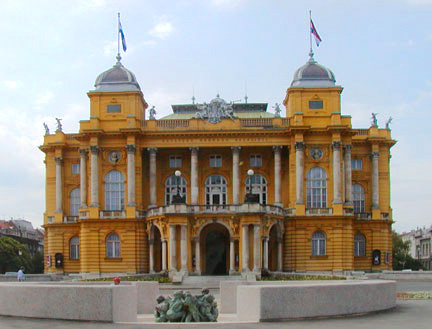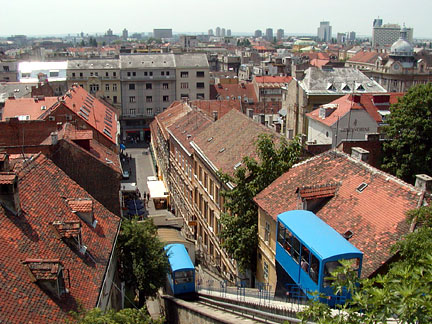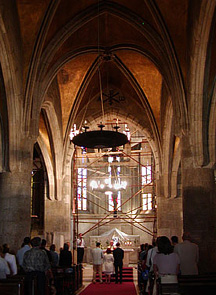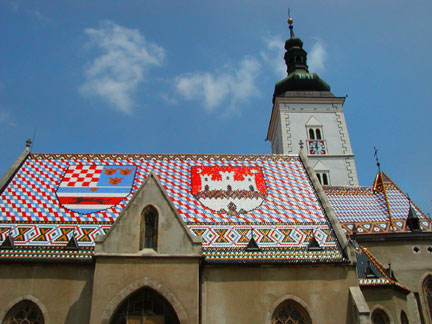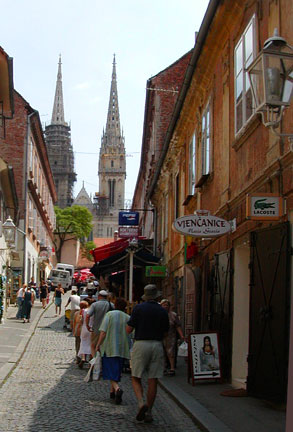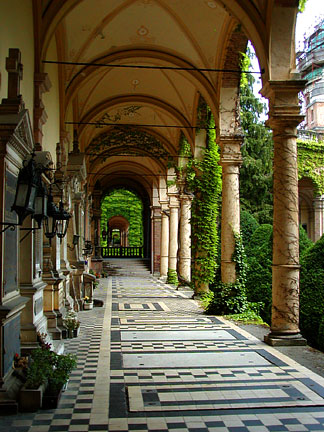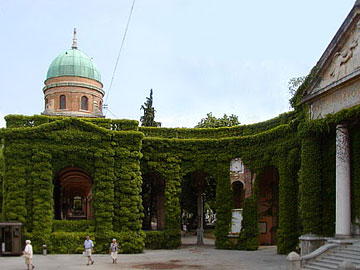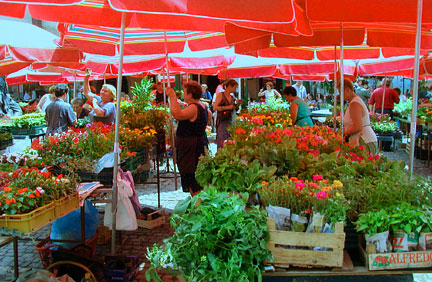|
We arrived in the capitol city of Zagreb in the midst of a heat wave in June, 2003. When Verna went to the Information Office to find out about accommodations, the young lady there explained that it was expected to be the hottest day Zagreb has seen in some 67 years. Not the day to be arriving in full motorcycle gear! Not to be deterred, we found a hotel, took a cool shower and headed off for our exploration of Zagreb.
Zagreb was originally 2 cities, Gradec and Kaptol. Gradec was the craftspeople’s quarter while the clerics had established themselves in Kaptol. Gradec was a fortified free city and remnants of the original wall and gates remain today. One gate, the Stone Gate, remains today after having been rebuilt in the 18th century and contains the shrine of Virgin Mary of the Stone Gate. Eventually the two towns merged and Zagreb grew and spread to the south during the 19th century. The 19th century Zagreb is where most of the businesses and hotels are today. The photo above right show the skyline of the newer part of the city from Gradec which sits above. In the lower part of the photo is the funicular which lifts people from the lower town to the old town. Today Zagreb accounts for 60% of Croatia’s GNP and contains a quarter of the 4 million population. As in other countries, people are coming to the city where more opportunities exist.
There is a wonderful minibus and walking tour offered by the Tourist Office that we took advantage of during our stay. The tour shows the visitor the highlights of the history and architecture of the city and is well worth the time spent. One of the architectural highlights is the Croatian National Theater seen above left. Like many other buildings in the city, it is painted a golden yellow, the royal color of Austria, a reminder of the years spent under Austrian rule. The theater was built in 1895 and is specially designed to present drama, opera, and ballet productions. The fountain in front is Ivan Mestrovic’s sculpture Fountain of Life (1905). Mestrovic is Croatia’s most famous modern sculptor.
bovet right, in old Gradec, St. Mark’s Church denotes the center of the old city with the Presidential palace and the Sabor (National Assembly) on either side. St. Mark’s Square is where all the important state functions are celebrated. The roof of this heavily restored 14th church is made of glazed tiles depicting the coat of arms of the Kingdom of Croatia, Dalmatia and Slavonia (left) and the coat of arms of the city of Zagreb (right). Inside, the graceful arches have been faithfully retained. When we were there, a baptism was taking place (above left ). Restoration on the interior is still under way as can be seen by the scaffolding.
|
While on our tour, we took a brief break for a drink in a comfortable old cafe in Gradec, above, right. On weekdays, the place would be full of politicians discussing the issues of the day. As it was Saturday, we had the place to ourselves. We were joined on the tour by a couple from South Africa so Jim and John were busy discussing places to see in that area.
|
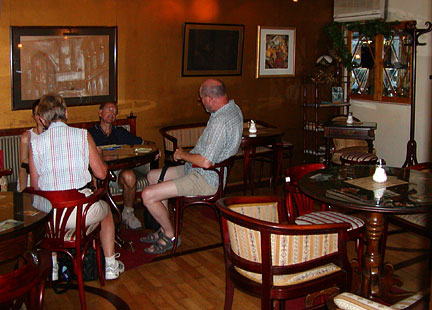
|
|
From Gradec we walked over to Kaptol, just a few blocks away. Along one busy street (below, left), Italian restaurants lined the right side of the street and the aroma of garlic was in the air. In the distance you can see the twin neo-Gothic towers of St. Stephen’s Cathedral, the center of the old Kaptol. While the original cathedral was built in the 13th century, it was destroyed by a massive earthquake and rebuilt in the neo-Gothic style in the 1880s. Surrounding the cathedral are the bishops palaces as well as two of the 16th century defensive towers build to protect the cathedral from the invading Turks.
Outside of the old town we visited the lovely cemetery Mirogoj. This is described as one of the finest cemeteries in Europe and it is definitely the most beautiful one we have ever seen. The front is a long wall with a series of towers. Inside, the wall is a long arch-covered path (above, right). The entrance below, left is densely covered in ivy. One of the many copper-covered towers can be seen above the vaulted walkway. The entire site is quite peaceful and beautiful. Although a bit of a drive out of town, it is well worth the visit.
Of course, every city has its colorful local market, and Zagreb is no different. In the Kaptol area you will find the Dolac vegetable market, which has a lot more than just vegetables. Below right is a photo of the flower market section, full of colorful cut flowers as well as blooming plants. Fruits and vegetables were well represented as well as basketry, household goods, and some clothing.
We also spent some time just walking through town and found a lot of shops full of just about everything you might need. There are a lot of sidewalk cafes where you can get a coffee or beer and watch the world go by. At night, street musicians often come to play for the customers enjoying the warm evenings and we were lucky enough to hear a great jazz quartet just outside our hotel. We found Zagreb to be a welcoming city and definitely worth a stay of several days. |

